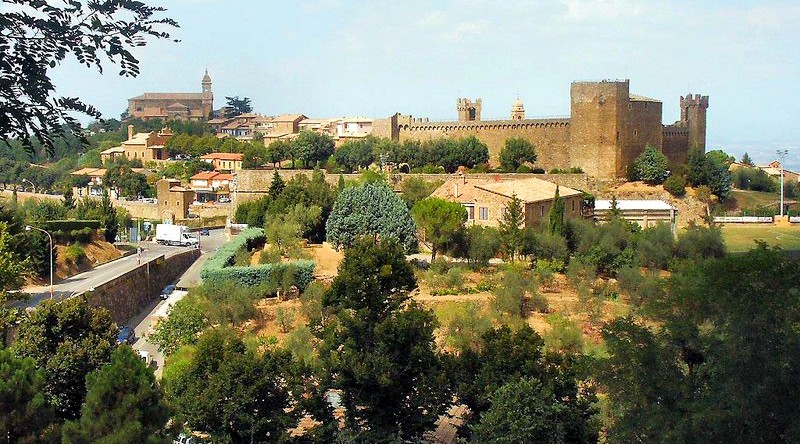
The town of Montalcino produces both Brunello wines and Rosso wines.
Rosso di Montalcino is proof of the great versatility of the sangiovese grape and of the fantastic terroir of the hill of Montalcino. Like Brunello, it is made from 100% sangiovese grape (known locally as sangiovese grosso or Brunello) from the same town of Montalcino in Tuscany. It shares many of the qualities of Brunello: a complex flavor profile, fantastic with food, and is produced by many of the same top producers of Brunello. But you don’t have to wait long to enjoy it or pay a high price.
The main difference arises from technical aging specifications. Rosso DOC may be released from September 1, the year following the harvest, with no oak-aging stipulations. In contrast, Brunello DOCG is subject to lengthy aging requirement of four years, two of which must be in oak and at least six months in bottle. Brunello may only be released from January 1, five years following the harvest. So while you will be able to buy 2020 Rossos in just a few months’ time, 2020 Brunellos will only be available in 2025.
This results in Rosso being a fresher, more approachable style of wine that can be drunk on release, as well as being fantastic value for money. They are usually half the price of Brunello or about $20 to $35 a bottle.
Created in 1984, the DOC allowed producers to improve their cash flow while waiting for Brunello DOCG to age. Fruit from younger vines could be used. It also created an appellation for any declassified Brunellos that did not reach the required standard after a couple of years of aging.
Read more: GREAT VALUE WINES: ROSSO DI MONTALCINO UNDER $25
However, the age of the vines in Montalcino, the winemaking and average quality of Rosso have greatly improved over the last decade or two. Marco Bacci, top Tuscan winemaker and entrepreneur who makes incredible Rossos and Brunellos di Montalcino at Renieri, observed that the difference in age of vines nowadays is not so important, especially at Renieri where the sangiovese vines were replanted in 1998 and 2000. “In the past [Rosso] was used as a degrade of the Brunello,” he said, adding that it “has definitely a great future.”
“Lots of Rosso are great and can rival with several Brunelli,” said Riccardo Campinoti, owner of Le Ragnaie, whose 2017 Rosso di Montalcino recieved 93 points last year in our tastings.
This certainly reflects top producers’ quality-focussed approach to making Rosso, too. Out of the 23 hectares owned by Le Ragnie, only six are for Brunello and four for Rosso; the rest are used for IGT wines. “I pay the same attention both in the vineyards and in the cellar that I do with Brunello”, said Riccardo. His Rosso is aged in big barrels for two years and is only released after two and a half years. “The idea is to have a wine that has complexity but also freshness, but I still want my Rosso to be a serious wine.”

These two Rossos are among our highlights in this list for their combined quality and value.
Federico Trost, general manager of Poggio Antico, described their different, but similarly quality-centric approach. Sangiovese grapes are used from the same three parts of the estate as for their Brunello (I Poggi, Lemartine and Madre), each providing a different characteristic to the final blend. “Our goal is to bottle a Rosso di Montalcino which represents Poggio Antico, with a unique finesse, freshness and fruit coming from the terroir,” he said.
A further attribute of Rosso over Brunello is greater consistency between vintages. Federico ascribed this “to the fact that in great years the quality of all the batches is excellent… while in the ‘normal’ years, we tend to bottle less Brunello di Montalcino. The batches used for the Rosso di Montalcino are very good indeed, as it happened for the 2018 vintage.”
The same is not necessarily true of other wineries, many of whom focus almost entirely on Brunello, particularly in great vintages such as 2015 and 2016.
Read more: $15 WINES THAT TASTE LIKE $50: SANGIOVESE
Nevertheless, “viticulture has dramatically improved in the vineyards and in the cellars of all the 260-ish producers”, said Federico, with Rosso di Montalcino included in this general process of improvement. As with Brunellos, the top Rossos show differences in character and personality between vintages, with 2017 having a richer fruit profile than 2018, reflecting the severely hot and dry conditions during the summer and harvest.
While Montalcino will always be famous and celebrated first and foremost for Brunello, Federico and many others are of the opinion that Rosso di Montalcino is becoming more appealing, particularly to consumers who are new to sangiovese and are yet to make the jump to Brunello in terms of complexity and price point. “In fact, you cannot always drink a big wine, sometimes you need a more approachable one. And I think that Rosso di Montalcino is the perfect opener.”
Below are 13 Rosso di Montalcino that won’t break the bank, all ready to enjoy now or within the next couple of years.
– Claire Nesbitt, associate editor

